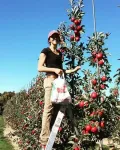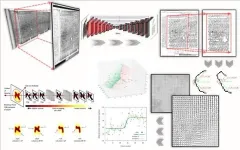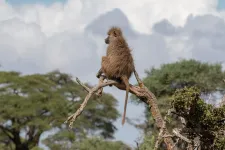Host, management, or microbial traits: Which is dominant in plant microbiome assemblage?
2021-04-21
(Press-News.org) We've all heard the news stories of how what you eat can affect your microbiome. Changing your diet can shift your unique microbial fingerprint. This shift can cause a dramatic effect on your health. But what about the microbiome of the plants you eat? Scientists are beginning to see how shifts in plant microbiomes also impact plant health. Unlocking the factors in plant microbial assemblage can lead to innovative and sustainable solutions to increase yield and protect our crops.
In a new study published in the Phytobiomes Journal, "Influence of plant host and organ, management strategy, and spore traits on microbiome composition," Dr. Frances Trail and her research group are interested in three factors that might attribute to microbial assemblage: the age of the plant, the organ or tissue type, and the management strategy. They followed a 3-year crop rotation that included corn, wheat, and soybean planted in a single field. They looked at a total of 24 plots under 4 different management strategies (6 plots/strategy): till, no-till, reduced chemicals, and organic.
Many factors drive crop microbial assemblage. Many researchers have looked at organic management strategies and how they might provide more diversity compared to conventional ones. Scientists believe that plant genetics also play a role in assemblage as each plant has a unique microbial fingerprint. Researchers have also shown microbes have adapted to a particular niche within the plant. Stems and leaves have a different nutrient niche than belowground compartments. The microbial profile of a leaf is often less diverse and different than the soil. What makes Trail's research unique is it's one of the first studies to look at all these factors (management strategy, host genetics, and tissue type) in one study.
The lead author on the paper, Dr. Kristi Gdanetz, was surprised by what she found to be the most important factor for microbial assemblage. She said, "the influence of management practices was not as strong an effect as I expected. It appears host genetics and plant location are more important indicators of community composition." Their research found that growth stages and tissue all had distinct microbial communities, particularly with bacterial communities.
The soil is the major reservoir for bacterial inhabitants of the plant with a few bacteria being carried by insects. Several studies, including Trail's, have shown bacterial profiles are most diverse and abundant within the soil. Above-ground organs, like the stem and leaf, are less diverse and harbor fewer microbes. Many bacterial inhabitants can be traced back to the soil, which suggests that the plant grants some microbes access to its tissues or the microbes may trick the plant to let them in.
The fungal route to the plant is more complicated. The roots and soil do not appear to be a major source of plant-associated fungi. Dr. Trail's research found that the alpha diversity of fungal communities did not decline from below- to above-ground tissues. Many fungal species form spores that wind, insects, and even humans can transport from one plant to the next. One major finding is that the shape, size, and other traits of the spore influence the host's fungal community. Specific sport traits may drive fungal assemblage to a specific niche (stem, leaf roots) within the plant.
Trail says, "When I realized that I could tie spore traits with the microbiome data, I was very excited, because this adds important information for how fungal microbiomes assemble, and the assembly of bacterial microbiomes as well." This unique finding became a focus of their research.
As this research unfolds there are many directions for future applications in sustainable agriculture, food production, and microbiology. Already we know several roles microbes play in crop health, such as enhancing immunity and nutrient cycling. Interacting and competing microbes might mask these roles. Dr. Trail is the first to show spore phenotypes influence the plant microbiome. With this knowledge, researchers can better understand microbial assemblage and use this information to increase yield. The researchers hope this knowledge will help develop new products to enhance crop sustainability.
INFORMATION:
Dr. Frances Trail is an established professor at Michigan State University and has mentored several aspiring scientists within her lab. Dr. Kristi Gdanetz is a postdoctoral scholar at Michigan State University who aspires to be a USDA scientist.
Author Bio: Tess Deyett, Ph.D. is a current postdoc under the guidance of Dr. Philippe Rolshausen at the University of California Riverside. She serves as an assistant feature editor for the Phytobiomes Journal. A passionate and driven science communicator, Tess also hosts her own website microbigals.com and podcast The Microbe Moment. She aspires to share how microbes are a constant force of good to every person and that everyone has many unique microbe moments!
[Attachments] See images for this press release:

ELSE PRESS RELEASES FROM THIS DATE:
2021-04-21
BUFFALO, N.Y. -- In nature, many molecules possess a property called chirality, which means that they cannot be superimposed on their mirror images (like a left and right hand).
Chirality can influence function, impacting a pharmaceutical or enzyme's effectiveness, for example, or a compound's perceived aroma.
Now, a new study is advancing scientists' understanding of another property tied to chirality: How light interacts with chiral materials under a magnetic field.
Prior research has shown that in such a system, the left- and right-handed forms of a material absorb light differently, in ...
2021-04-21
Plenty of people struggle to make sense of a multitude of converging voices in a crowded room. Commonly known as the "cocktail party effect," people with hearing loss find it's especially difficult to understand speech in a noisy environment.
New research suggests that, for some listeners, this may have less to do with actually discerning sounds. Instead, it may be a processing problem in which two ears blend different sounds together - a condition known as binaural pitch fusion.
The research, co-authored by scientists at Oregon Health & Science University and VA Portland Health Care System, was published today in the Journal of the Association for Research ...
2021-04-21
When deciding whether to have children, there are many factors to consider: finances, support systems, personal values. For a growing number of people, climate change is also being added to the list of considerations, says a University of Arizona researcher.
Sabrina Helm, an associate professor in the Norton School of Family and Consumer Sciences in the College of Agriculture and Life Sciences, is lead author of a new peer-reviewed study that looks at how climate change is affecting people's decisions about whether to have children.
"For many people, the question of whether to have children or not is one of the biggest they will face in their lives," Helm said. "If you are worried ...
2021-04-21
By targeting a receptor in the brains of mice, researchers have successfully altered feeding and anxiety-like behaviors linked to anorexia. Although more work is needed in humans, their study suggests that fine-tuning the receptor's activity could help change feeding habits and promote weight gain in patients with eating disorders. Anorexia and other eating disorders affect at least 28 million Americans and cause more than 10,000 deaths in the U.S. each year, according to the National Association of Anorexia Nervosa and Associated Disorders. Studies have linked anorexia to neurons that bear a protein named AgRP; these neurons reside in an area of the brain ...
2021-04-21
Video: https://bit.ly/pelicanflightvideo
It's a common sight: pelicans gliding along the waves, right by the shore. These birds make this kind of surfing look effortless, but actually the physics involved that give them a big boost are not simple.
Researchers at the University of California San Diego have recently developed a theoretical model that describes how the ocean, the wind and the birds in flight interact in a recent paper in Movement Ecology.
UC San Diego mechanical engineering Ph.D. student Ian Stokes and adviser Professor Drew Lucas, of UC San Diego's Department of Mechanical and Aerospace Engineering ...
2021-04-21
Like humans, certain plants are treated with antibiotics to ward off pathogens and protect the host. Saving millions, antibiotics are one of the 20th century's greatest scientific discoveries, but repeated use and misuse of these life-saving microbial products can disrupt the human microbiome and can have severe effects on an individual's health. Overuse has led to several microbes developing resistance to the antibiotic, rendering it useless, and created "superbugs" that overpower medication. But do we find that same phenomenon in plants and our food industry?
This was the question Dr. Anna Wallis ...
2021-04-21
Handwriting analysis of one of the Dead Sea Scrolls indicates the biblical text was likely written by multiple scribes, who mirrored one another's writing styles.
INFORMATION:
Article Title: Artificial intelligence based writer identification generates new evidence for the unknown scribes of the Dead Sea Scrolls exemplified by the Great Isaiah Scroll (1QIsaa)
Funding: 'Mladen Popovi? Project: The Hands that Wrote the Bible Grant Number: ERC Starting Grant 640497 European Research Council https://erc.europa.eu/ The funders had no role in study design, data collection and analysis, decision to publish, or preparation of the manuscript.'
Competing Interests: The authors have declared that no competing interests exist.
Article URL: https://journals.plos.org/plosone/article?id=10.1371/journal.pone.0249769
...
2021-04-21
Weight gain in older age does not appear to preserve cognitive performance, according to study of 58,389 European adults
INFORMATION:
Article Title: Bodyweight change and cognitive performance in the older population
Funding: None of the authors of the manuscript has received specific funding for the work included in this submission. The funders mentioned below did not play any role in the study design, data analysis, decision to publish, or preparation of the manuscript. The SHARE data collection has been primarily funded by the European Commission through FP5 (QLK6-CT-2001-00360), ...
2021-04-21
DURHAM, N.C. -- Female baboons may not have bills to pay or deadlines to meet, but their lives are extremely challenging. They face food and water scarcity and must be constantly attuned to predators, illnesses and parasites, all while raising infants and maintaining their social status.
A new study appearing April 21 in Science Advances shows that female baboons with high life-long levels of glucocorticoids, the hormones involved in the 'fight or flight' response, have a greater risk of dying than those with lower levels.
Glucocorticoids are a group of hormones ...
2021-04-21
In a world-first, researchers from the Okinawa Institute of Science and Technology Graduate University (OIST) have captured an image showing the internal orbits, or spatial distribution, of particles in an exciton - a goal that had eluded scientists for almost a century.
Excitons are excited states of matter found within semiconductors - a class of materials that are key to many modern technological devices, such as solar cells, LEDs, lasers and smartphones.
"Excitons are really unique and interesting particles; they are electrically neutral which means they behave very differently within materials from other particles like electrons. Their presence can ...
LAST 30 PRESS RELEASES:
[Press-News.org] Host, management, or microbial traits: Which is dominant in plant microbiome assemblage?




